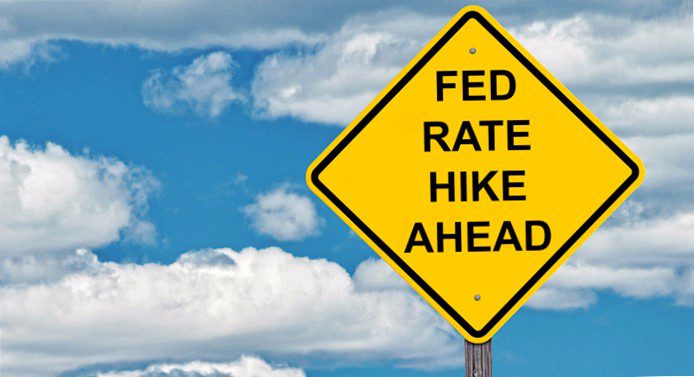
The market priced in probability of a 50 basis point move by the Fed as early as March shot up to nearly 86% in the wake of the latest inflation figures. It would be the first time in more than 20 years that the Fed has raised interest rates in one step by more than 25 basis points. This has significantly increased the risk of a policy error, says Martin Luck of BlackRock.
U.S. consumer price inflation rose to 7.5% in January, the highest in 40 years and once again higher than the December reading (7.0%) than the consensus had expected. "What weighed more heavily was the fact that inflation seems to be spreading from exclusively Covid-related components – such as so-called 'stay-at-home goods' – into various categories of the basket, including many services", says Martin Luck, Head of Capital Markets Strategy in Germany, Switzerland, Austria and Eastern Europe at BlackRock. The core inflation rate, from which the most volatile components energy and food are excluded, accelerated from 5.5% in December to 6.0% in January.
"It is probably this picture of spreading inflation, more than anything else, that has caused market participants to significantly tighten their expectations about the Fed's response", comments Luck further. In the wake of the inflation data release, the number of rate hikes priced into fed funds futures for this year had risen to more than six, and at its peak, nearly seven. This would mean that the Fed would shoot almost all its powder regarding the total expected interest rate steps (the majority of expectations regarding the 'terminal rate' are in the range of 1.75-2.0%) already this year.
Adding fuel to the fire
As the capital markets strategist goes on to point out, recently James Bullard, the governor of Federal Reserve St. Louis, who is a voting member of the crucial Federal Open Market Committee (FOMC) this year, adds fuel to that fire. In view of this high inflation data, Bullard says, he would like to be able to make up to 1. July to see 100 basis points of rate hikes bagged (quote: "I'd like to see a 100 basis points in the bag by July 1"). The market's priced-in probability of a 50 basis point move by the Fed as early as March then shot up, from 48% in the aftermath of the CPI numbers to nearly 86%.
"It would be the first time in over 20 years that the Fed has raised interest rates in one step by more than 25 basis points. Thus, the risk of a policy error has increased significantly. This is because such a rapid increase in refinancing costs would massively tighten financing conditions, especially in conjunction with the liquidity squeeze caused by the rapid expiry of bond purchases.", Luck points out and continues: "But these affect the demand side of the economy, investment and consumption, and thus such a tightening would mean a dampening of aggregate demand, with presumably noticeable consequences for growth and employment."
In the face of inflation, on the other hand, which is driven by the supply side (energy prices, bottlenecks in supply chains, etc.), the risk of a policy error on the part of the Fed is very high.), he believes that this would probably have little effect until demand-side prices, such as wages, begin to fall. "In other words: If a central bank really wants to break a supply-side price shock, it will have to slow down the economy drastically, even downright stall it", according to the capital market strategist. However, this does not seem to be the goal in view of the current economic situation, in which the central banks are presumably more concerned with normalizing monetary conditions after Covid – certainly not if one takes into account the new Fed strategy, which was only adopted in August 2020.
"In the big picture, this paints a picture of an FOMC that is feeling the pressure from the public in the face of extremely unpopular inflation trends and is starting to get very cold feet", Luck further comments. For markets, this increases the likelihood that some of the now priced-in six-plus rate hikes will disappear from fed funds futures by year-end. After the recent significant flattening of the yield curve, there are likely to be episodic market phases in which the curve steepened.
Puzzlement over Russia's course
In addition to the central banks, Russia's military buildup on the border with Ukraine is keeping the markets on tenterhooks. In the opinion of the capital market strategist, it is striking how differently the concrete risk of war is seen depending on where one looks. If Western experts on security and military strategy are to be believed, the likelihood of an attack has increased to over 70% with Russia's deployment of what is now probably a good 130,000 troops on the border with eastern Ukraine and from the north in Belarus. U.S. intelligence agencies are even said to have today, the 16. February, have identified as the day of entry. Western governments strongly advise compatriots to leave Ukraine. By contrast, analysts on the ground, i.e. in Ukraine itself and also in Russia, generally see the risk of war as considerably lower, at only 10%, and point to the immense damage of a war for all parties involved.
"The fact is that an actual escalation would also have massive consequences for the financial markets, from the risk-off of a war on European territory to dramatically rising energy prices and consequences for global trade. Should Russia's army actually invade Ukraine, whether before the end of the Winter Olympics or only afterwards, this could make the difference for stock investors for 2022 as a whole. The difference between an exhausting, but just good year, and one to forget", says Luck.